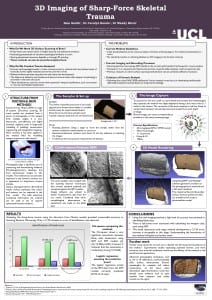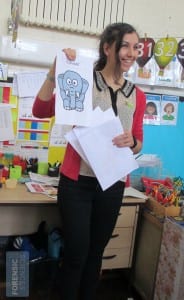MORPH2016: Measuring our models
By Sian E Smith, on 5 July 2016
Our friends in the Institute of Archaeology (IOA) hosted a conference last month- Morph2016 : Morphometric Applications in Archaeology and Anthropology
Geometric morphometrics (GMM) is the quantitative measurement of morphological shape using geometric co-ordinates, rather than just measurements. Using CAD (computer assisted design) methods the geometry of an object can be captured with outline and landmark data, and 3D surface representations. Morphometric-based methods are increasingly used in diverse areas such as molecular genetics and environmental science, but they have become particularly relevant in archaeology and anthropology.
There was a wide variety of speakers including some of our CFS researchers and from the IOA.
Agathe Ribereau Gayon gave a presentation on an important discovery in her research so far. She observed a unique type of trauma on human remains in an oceanic environment; she discussed how she utilised 2D-photogrammetric methods to capture and categorise the geometric data of the trauma.
I presented a poster on my MRes project; a ‘proof of methodology’ study on the use of 3D-photogrammetry (specifically structure from motion) for modelling and analysing sharp-force trauma on bone. 3D-photogrammetry is commonly used in large-scale modelling of built environments and archaeological sites for example. By using macro lenses and adjusting the lighting conditions I have been able to apply this on a much smaller scale to create interactive models with sufficient details for weapon classification. We achieved a high level of success in distinguishing serrated from non-serrated blade edges, when compared to the current standard method of Scanning Electron Microscopy.

My research poster
Lily Stokoe, from the Institute of Archaeology, has been utilising 3D scanning to study the aetiology of osteoarthritis. This is an enduring mystery for osteologists and medical researchers. Using the 3D scans, she is able to take accurate measurements of the angles in the femur to identify potential biomechanical and lifestyle causes.
Dr Carolyn Rando talked about the challenges of integrating morphometrics into teaching. It has become an important part of how we analyse geometric data in archaeology and anthropology, but if you have a room full of students with different levels of tech skill, how do you make it accessible to all of them? By getting hands on with a simple, structured practical taking measurements from a skull, beginners through to more advanced students can understand where these methods can be beneficial.
Since Carolyn started teaching this, the IOA has gone from having very few students working in GMM to having a wide range of Msc and PhD students working on different applications of 2D and 3D imaging methods.
The committee organised a great conference; with the diverse group of speakers the conference explored a range of methodologies, practical applications, and key issues in the field.
Catch up with the tweets from the event with #MORPH2016
 Close
Close








